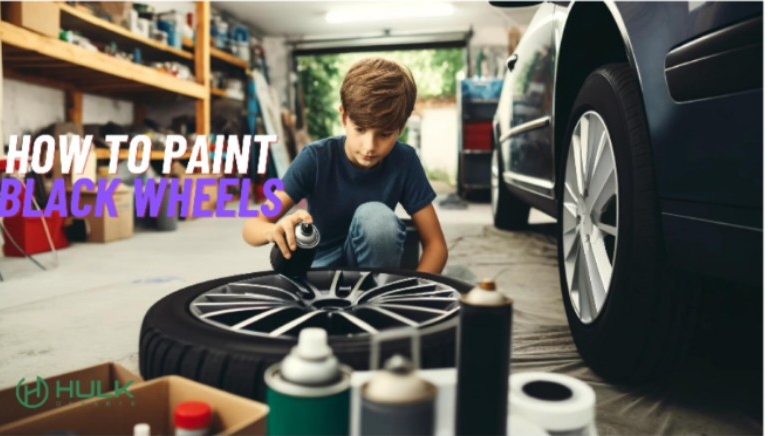Introduction
A classic style in the automotive industry are black wheels. Any car may be transformed and made to stand out on the road by their aggressive and sleek appearance. Though many enthusiasts use aftermarket wheels to get this appearance, you can get the same effect with a little work and imagination without having to pay a premium for factory black wheels. We will go over how to paint your wheels black in this tutorial so they look good and last.
Preparation
Gathering Materials and Tools
Get together all the equipment and supplies you will need before starting painting. Sandpaper, primer, black wheel paint, clear coat, masking tape, plastic sheeting, degreaser and a microfiber cloth will all be needed. To defend against dust and fumes, this project also calls for some basic safety equipment, such as gloves, a mask and safety glasses.
Safety Precautions
Safety has to always come first. Make sure you’re working somewhere well ventilated to prevent breathing in dangerous pollutants. Gloves will cover your hands from chemicals and safety glasses from paint splashes and debris. Plastic sheeting will also facilitate cleanup and keep paint off your garage floor.
Prepping the Wheels
Removing the Wheels from the Vehicle
Take the wheels off of your car carefully first. While the car is still on the ground, loosen the lug nuts; then, jack it up and completely remove the nuts to remove the wheels. Giving a stable and easily accessible surface for painting depends on this stage.
Cleaning the Wheels
Take the wheels off and thoroughly clean them. Brake dust, grease, and dirt can all be removed with a degreaser. Painting sticks better and lasts longer on a clean surface. Before going any further, wipe down each wheel with a microfiber cloth and make sure they are totally dry.
Sanding the Wheels
Part of the preparation procedure is sanding. It takes off the current paint and leaves a rough surface on which the fresh paint can stick. For a smooth finish, start with coarse grit sandpaper and work your way to finer grit. Give any cuts or scratches additional care, sanding them down as much as you can.
Masking and Covering
Any part of the wheel—like the tires, valve stems, and lug nut holes—that you don’t want painted should be mask off. Use masking tape and plastic sheeting to cover these areas properly. This will guarantee a tidy, expert-looking finish and shield them from overspray.
Painting Process
Applying Primer
A long-lasting finish depends on primer. It gives a strong foundation and aids in the paint adhesion. Put on the primer in thin, even coats, letting each one dry before adding the next. Usually two or three coats are plenty. As for drying times, refer to the manufacturer’s directions.
Painting the Wheels Black
The thrilling part is now finishing the wheels in black. Select a premium black wheel paint made to last. To prevent drips and runs, paint in light, even coats. Typically, three to four coats will give you a rich, deep black finish. Apply the next coat only after letting the previous one fully dry. Think of Azara stylish Wheels as your style and quality guide for a high-end appearance. Their creations can motivate you to turn in a polished result.
Applying Clear Coat
Your wheels’ shiny, protective finish is completed by the clear coat. It shields the paint from the weather and aids to seal it. Put on two or three clear coats, letting each dry entirely in between. A professional look and long-lasting durability depend on this stage.
Finishing Touches
Drying and Curing
It takes patience to dry and cure something. Before handling your painted wheels, let them dry for a minimum of 24 hours. Allow a few days for curing for the best effects to guarantee the paint is completely hardened and long-lasting.
Inspecting the Finish
Check the wheels very closely after they have dried. See what might require touch-ups. A light coating of paint and some sanding can correct small flaws. A professional look requires a consistent, clean finish.
Reinstalling the Wheels
When the finish is to your liking, put the wheels back on your car. Holding them firmly in place, tighten the nuts by hand. Lower the vehicle and then, following the manufacturer’s requirements, tighten the lug nuts using a torque wrench. This stage guarantees that your wheels are safely fastened and roadworthy.
Maintenance and Care
Regular Cleaning
It takes maintenance to keep your just painted wheels appearing new and fashionable. A mild, non-abrasive wheel cleanser used on a regular basis will help to maintain the finish. Steer clear of applying aggressive chemicals or abrasive brushes that could harm the paint.
Touch-Up Tips
Your wheels may chip or scrape over time. For touch-ups, have a little paint and clear coat on standby. After cleaning and lightly sanding the damaged area, paint a thin coat there and then clear coat it. This will prolong life and maintain the perfect appearance of your wheels.
Conclusion
Rewarding do-it-yourself activity, painting your wheels black can completely change the appearance of your vehicle. You can get a long-lasting professional finish with the correct supplies and preparation. Thus, gather your materials, go slowly and enjoy the amazing new appearance of your black wheels.
FAQs
Q: How long does the entire painting process take?
A: A few hours can pass while you paint, but you have to allow for drying and curing periods in between applications. For a long-lasting and polished finish, the job could take a few days overall.
Q: Can I use any type of paint for my wheels?
A: Use of paint made especially for wheels is crucial. Paint of this kind is made to resist the heat and weather that wheels encounter. Common paints did not last long and could peel or crack easily.
Q: How do I maintain the painted wheels?
A: The secret is to clean your wheels often using a non-abrasive cleanser. For scratch prevention, stay away from strong chemicals and use a gentle brush or cloth. To maintain the wheels looking their finest, quickly fix any chips or scratches.
Q: What if I want to change the color in the future?
A: You’ll need to take comparable actions if you choose to change the color later: Sand, prime, paint, mask, clean, and clear coat in that order. To guarantee the new paint sticks well, the old paint must be removed or roughened up.
Q: Is it worth painting my wheels myself or should I get them professionally done?
A: Painting wheels yourself can be cost-effective and satisfying if you have the time and patience. But hiring them professionally painted is a terrific choice if you want a perfect, expert finish and don’t mind the added expense.










